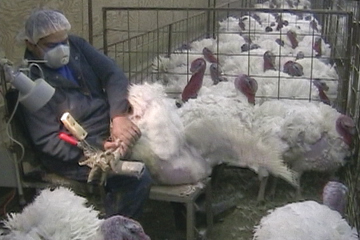 |
A factory farm worker
forcing a “tom” into leg restraints to collect
semen, as other “toms” look on. Photo courtesy
of Farm Sanctuary
|
Farm Sanctuary recently went undercover at one
of the largest U.S. turkey breeding facilities. Investigators
obtained rare
photos and other documentation revealing rampant callousness
and cruelty. At this operation located in the “heartland,” more
than 100,000 turkeys are exploited and tens of millions of poults
(baby turkeys) are hatched each year. These poults are specifically
raised for slaughter by some of the most well-known brands found
in grocery store freezers. One breeding company representative
proudly proclaimed “What you buy in the grocery store at
Thanksgiving—it all starts here. We produce the poult,
they buy the poult, they raise the poult and take him to
slaughter.”
The Making of a Turkey
Like the livestock and chicken industry, turkey “growers” have
increased the efficiency of producing turkey meat by manipulating
every aspect of the animals’ lives. To appease consumer
demand for white meat, today’s domesticated turkeys are
anatomically manipulated to be so large breasted and heavy they
are incapable of breeding without human intervention. Workers
are required to manually manipulate the genitalia of male turkeys
(toms) and then forcibly inseminate female turkeys (hens)—a
form of legalized bestiality and rape in animal agriculture.
Breeding toms languish for roughly one year in dark crowded
pens and are ‘milked’ once
or twice a week. Approaching the barn, we were told, “It’s gotta
be dark in there. Toms only need so much light in the mornings and evenings to
stimulate them to milk. The rest of the time doesn’t matter. They can be
totally ‘darked out.’”
In describing the milking process a worker explained, “It’s totally
different than what people imagine. I can tell you right now—you’re
gonna be shocked… Basically I’ll give you the short run down
of it. We got a tom bench in the barn. The guys pick the toms up and put
them
on the
bench and they rub them up, squeeze them, and it ejaculates the tom. The
semen is sucked up through the filtration system and sent through a valve...”
We documented a worker, donned in a mask and hairnet, sitting at the “tom
bench” collecting semen from turkeys clamped in metal contraptions.
There were no lights except for a single bulb lamp. The worker grabbed each
turkey
and forcefully restricted his legs in a clamp attached to the bench. Using
a straw attached to a suction hose, he collected semen then tossed the bird
to
the floor so he could grab the next and repeat the process.
Between ‘milking’ sessions, 16 to 17 male turkeys are crammed into
five and a half square feet wire pens—this means each large adult turkey
only has the space of an average folding chair seat, in which to live.
For each male exploited for breeding, there are more than 20 females who
are also subjected to abusive housing and handling. Semen is forced into
hens in
an assembly line fashion. As with the male turkeys, the females’ legs
are clamped into metal forceps. Each laborer inseminates an average of 1,200-1,400
hens within two hours.
Regarding inseminating techniques, a supervisor said, “The depth that they
inseminate is different. Not everyone is going to inseminate the same way. So
really the only difference is how they crack the bird out, how deep they go and
how they hold the gun and put it in the hen to inseminate them.” The hens
suffer during the process and try to resist. We observed employees pushing and
pulling fearful turkey hens through a small door, into the artificial insemination
(AI) room, and we were told that young hens are curious and friendly with employees “until
the first couple AIs—and then they run from you...”
Music blares in the background of this house of horrors, as we come to a
pile of dead turkeys lying on the floor and others stuffed into plastic bags
near
a wheelbarrow. Referring to the number of hens in a specific barn, a worker
said, “When
I brought them in, there was like 3,000. There’s probably about 2,800 now.
As time goes on, you know, they die all up… And they take them out and
put them to slaughter...” Those who don’t die during the process
are typically killed before their second birthday and used, along with their
millions of offspring, for food.
The turkey industry is responsible for widespread animal abuse, from beginning
to end. The violence perpetrated at the slaughterhouses is the final insult.
When asked about the state of the turkey business, an industry representative
bragged, “It’s thriving….The more people that eat turkey
the better we are.”
It is therefore even more imperative that we expose the turkey industries’ dirty
little secret.
Meghan Beeby works in Farm Sanctuary's campaign department and has been with
the organization for three years. Additional information can be found at
www.farmsanctuary.org or by calling (607)583-2225.
|